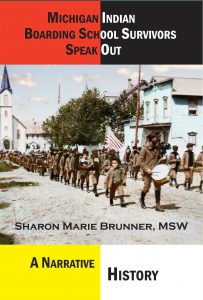Review by Jon C. Stott.
“Kill the Indian and Save the Child.”
 This nineteenth-century “altruistic” motto was used by White government and church officials to explain their “saving” of supposedly inferior native children by inculcating supposedly superior cultural and spiritual values in the children under their care at Indian boarding schools. The education they would receive would lead them to a better way of life, but one inferior to that of the dominant white/European culture. Unfortunately, as research and recent discoveries have revealed, all too often only the first goal expressed by the “motto” was achieved – spiritually, culturally, and, tragically, far too often literally.
This nineteenth-century “altruistic” motto was used by White government and church officials to explain their “saving” of supposedly inferior native children by inculcating supposedly superior cultural and spiritual values in the children under their care at Indian boarding schools. The education they would receive would lead them to a better way of life, but one inferior to that of the dominant white/European culture. Unfortunately, as research and recent discoveries have revealed, all too often only the first goal expressed by the “motto” was achieved – spiritually, culturally, and, tragically, far too often literally.
In Michigan Indian Boarding School Survivors Speak Out, social worker Sharon Marie Brunner, a member of the Sault Ste Marie Tribe of Chippewa Indians and daughter of a woman who had attended a Michigan Indian boarding school, has presented a carefully and thoroughly researched account of how boarding schools went about “solving” what was considered the “Indian problem” – how to deal with people who were so different culturally from the European colonists and who often lived on the best lands and who stood in the way of “progress” and the fulfillment of “manifest destiny.” The core of the narrative is a series of interviews with nine still-living survivors, several of them residents of Michigan’s Upper Peninsula. They had attended either Holy Childhood of Jesus Indian School (run by Catholic nuns and priests) or the government-run Mount Pleasant Indian Industrial Boarding School. Both institutions were located in the Lower Peninsula far from the homes from which the young children were taken.
The opening three chapters present a detailed, well-documented overview of the methods used at Indian boarding schools to “save the child.” Brunner notes that these included punishing the young children now living far away from their homes and cultural groups for speaking their native tongues. Captivity and “coercive control” included physical, emotional, and sexual abuse. Children were told that if they did not embrace Christianity – which meant rejecting their heritage – they would burn in hell. Interestingly, Brunner notes, that many of the educational practices were modeled on those used to “rehabilitate” inmates in prisons and penitentiaries. For a very large numbers of the Indian school “graduates,” their afterlives included domestic violence, poverty, depression, and substance abuse.
The people Brunner interviewed ranged in age from the early nineties to the mid-forties. The fact that two were in the lowest age group is significant: Indian schools were not only evil institutions from the dark past, but existed into the last half of the twentieth century. Generally, those attending the government-run Mount Pleasant School seem to have been less devastated by their experiences than those attending the religious-based Holy Childhood. Nonetheless, all were affected. Without summarizing the narratives, which need to be read in their entirety, it is worth including a few quite shocking statements. One observer reported that his family was “put … on a reservation that a wolf would starve to death on.” Another reported, “I was like a slave,” while another said, “I was deteriorating.” “It was designed to really break you down,” was one harsh statement. “It was a suffering place,” was one lament. Another called it “the school of hell.” “My best experience … was going home,’ ironically remarked one of the former students. Practically, most of them learned menial skills, abilities that would make them useful servants of, but inferior to the dominant white culture.
Brunner has written a book that is at once strongly objective and deeply personal. As a reader, I would have found it rewarding to have learned more about her research and interviewing as personal experiences. Nonetheless, she has written an extremely important study of a program that in many ways created so many more problems, often deeply tragic, than it solved. It is a must-read for everyone who wishes to know the effects of government and religious educational programs that are often repressed or forgotten aspects of American history.
–Jon C. Stott, author Native Americans in Children’s Literature.
Sharon Brunner. Michigan Indian Boarding School Survivors Speak Out: A Narrative History. Ann Arbor, MI: Modern History Press, 2024.



